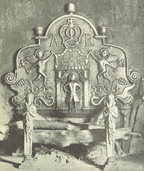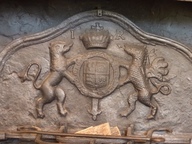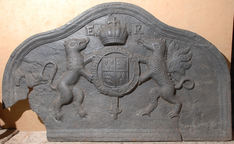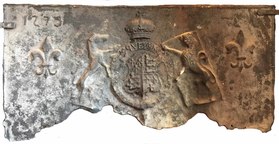-
1209
Description: Individually designed quasi-arched rectangular shape; astragal edging; central portico with framed doorway and sloping roof, in which stands a male figure dressed in contemporary style; above the roof, the date, and above that, the initials R R separated by a flower head, this inscription enclosed within a five-sided ribbon compartment held at the top corners by a pair of mirrored dancing cherubs each of which holds in their outer hand a wand surmounted by a fleur-de-lys; below them are mirrored vine designs terminating in a grape bunch, and below each of them a mirrored swirled snake, its head reversed; towards the outer side of these snakes are a pair of mirrored birds within a curved cartouche of slightly raised relief that is associated with a swirl on each side of the fireback that terminates the astragal edging on each side and which ascends via a step surmounted by a miniature urn on each shoulder of the back to the top which is surmounted by an acorn shape; above the ribbons held by the cherubs, is a stylised crown between the initials GR; the above features are limited by a horizontal astragal, though the portico descends below it, and which is supported at each end by a simple Doric column enclosing the bottom panel which is otherwise plain.
Notes: The initials GR are of Georgius Rex - King George I. Finely cast but of naïve design, another fireback of the same design but with different inscriptions and dated 1714 is at Low Graythwaite in Hawkshead parish, which was home to the Rawlinson family who, in 1711, built the first blast furnace in what was then the northern part of Lancashire.
Inscription: G R / R R / 1723
- Decoration tags:
- quasi-arched rectangular with extensions (shape)
- astragal (edging)
- whole carved pattern
- individual letters
- individual numbers
- heraldic
- mythological
- text
- humans
- plants
Manufactured: in 1723 possibly at Backbarrow Furnace in the Furness area of England.
Current location: Blackwell House, Bowness-on-Windermere, Cumbria, England.
- Attached to series:
- Date & initials firebacks
- Rawlinson series
-
1210
Description: Individually designed quasi-arched rectangular shape; astragal edging; central portico with framed doorway and sloping roof, in which stands a male figure dressed in contemporary style; above the roof, the date, and above that, the initials TKM arranged in triad and around a flower head, this inscription enclosed within a five-sided ribbon compartment held at the top corners by a pair of mirrored dancing cherubs each of which holds in their outer hand a wand surmounted by a fleur-de-lys; below them are mirrored vine designs terminating in a grape bunch, and below each of them a mirrored swirled snake, its head reversed; towards the outer side of these snakes are a pair of mirrored birds within a curved cartouche of slightly raised relief that is associated with a swirl on each side of the fireback that terminates the astragal edging on each side and which ascends via a step surmounted by a miniature urn on each shoulder of the back to the top which is surmounted by an acorn shape; above the ribbons held by the cherubs, is a stylised crown between the initials AR; the above features are limited by a horizontal astragal, though the portico descends below it, and which is supported at each end by a simple Doric column enclosing the bottom panel which is otherwise plain.
Notes: The initials AR are of Anna Regina - Queen Anne. Finely cast but of naïve design, another fireback of the same design but with different inscriptions and dated 1723 is Bowness on Windermere. Illustration from Cowper, 1899, p.179.
Inscription: A R / TKM [triad] / 1714
- Decoration tags:
- quasi-arched rectangular with extensions (shape)
- astragal (edging)
- whole carved pattern
- individual letters
- individual numbers
- heraldic
- mythological
- text
- humans
- plants
Manufactured: in 1714 possibly at Backbarrow Furnace in the Furness area of England.
Current location: Low Graythwaite, Hawkshead, Cumbria, England.
- Attached to series:
- Date & initials firebacks
- Rawlinson series
-
1213
Description: Rectangle with curved shoulders and low arch joined with concave curves; fillet and ogee moulded edging; central Tudor royal shield surrounded by garter, with crown above and lion and dragon supporters; royal initials either side of crown.
Notes: On other castings of this fireback the initials are 'ER', the 'I' for James having been substituted here for the 'E' for Elizabeth but incorrectly retaining the Tudor shield. The garter motto includes ‘EQVI’ instead of ‘HONI’, making it meaningless; possibly ‘EQVI’ was a mis-transcription of ‘HONI’; the crown is distinctly continental in form.
Inscription: I R
Arms: Tudor royal - Edward VI or Elizabeth I
- Decoration tags:
- quasi-arched rectangular (shape)
- fillet and ogee (edging)
- whole carved pattern
- individual letters
- heraldic
- armorial
- royal
- text
Manufactured: in the early 17th century in England.
Current location: Prior's Hall, Durham Cathedral, Durham, County Durham, England.
- Attached to series:
- Jacobean royal armorial firebacks
- Garter error series
-
60
Description: Fragment; rectangular; flanged top edge; probable symmetrical arrangement of crowned Tudor royal shield stamps (4 above 3); vertical line on either side of each shield; left hand print in bottom left corner, probably mirrored on right.
Notes: The right side of the fireback is missing. Very crude modelling of stamp suggests an early date; the same crowned shield and use of hand print can be seen on a fireback at Rolvenden (no. 661), indicating a common source..
- Decoration tags:
- rectangular (shape)
- flanged (edging)
- simple stamps
- carved stamps
- heraldic
- humans
Manufactured: in the early to mid 16th century in the Weald area of England.
Current location: in private hands, Etchingham, East Sussex, England.
- Attached to series:
- Hand print firebacks
- Early Tudor series
- Tudor royal armorial firebacks
-
303
Description: Rectangle with curved shoulders and low arch joined with concave curves; fillet and ogee moulded edging; central Tudor royal shield surrounded by garter, with crown above and lion and dragon supporters; royal initials either side of crown.
Notes: Damaged on bottom left corner; the garter motto includes ‘EQVI’ instead of ‘HONI’, making it meaningless; possibly ‘EQVI’ was a mis-transcription of ‘HONI’; the crown is distinctly continental in form; a much-copied fireback. Previously at Hoarthorns Farm, West Dean, Gloucestershire, where another fireback of the same design was recovered from a pond and is now at the Forestry Commission camp site at Christchurch, near Coleford.
Copies of this fireback are known.
Inscription: E R / EQVI : SOIT : QVI : MAL : Y : PENSE
Arms: Tudor royal - Edward VI or Elizabeth I
- Decoration tags:
- quasi-arched rectangular (shape)
- fillet and ogee (edging)
- whole carved pattern
- planklines
- armorial
- royal
- text
Manufactured: in the mid to late 16th century possibly in the Forest of Dean area of England.
Current location: Gloucester Folk Museum, Westgate street, Gloucester, Gloucestershire, England.
Museum number: GLRCM:F03526 (part of the Gloucester Museums museum group)
-
1226
Description: Rectangular; rope edging (top & sides); in centre, Tudor shield, garter, crown and supporters (greyhound and lion) between two fleurs-de-lys; date top left.
Notes: A badly corroded fireback. The armorial achievement is seen on other firebacks and was formed from four separate stamps; the supporters are consistent with the date; the style of the numerals is uncharacteristic of the period. The sharpness of the detail on the crown and upper part of the Garter indicates that the fireback is contemporary with the date, and not older as similar examples seem to be. The same date in identical form is on a similar fireback at Penshurst Place, Kent.
Inscription: 1579 / [Garter motto incomplete]
Arms: Tudor royal
- Decoration tags:
- rectangular (shape)
- rope (edging)
- carved stamps
- date stamp
- heraldic
- armorial
- text
- animals
Manufactured: in 1579 in the Weald area of England.
Current location: Groombridge Place, Speldhurst, Kent, England.
- Attached to series:
- Tudor redated series
- Pounsley series
- Tudor royal armorial firebacks





